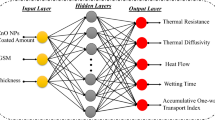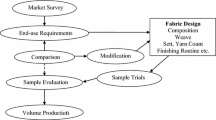Abstract
Optimization of woven fabric parameters for ultraviolet protection factor (UPF) and comfort properties has been attempted using hybrid artificial neural network (ANN)–genetic algorithm (GA) system. ANN was used for developing the prediction models, and GA was employed as an optimization tool. Four feasible combinations of UPF, air permeability and moisture vapor transmission rate (MVTR) were chosen from the Pareto charts of UPF–air permeability and UPF–MVTR. Penalty function method was adopted to form a single objective function by combining the objectives and constraints related to UPF, air permeability and MVTR. The developed ANN–GA hybrid system was executed to obtain the solution set of input parameters for achieving the targeted fabric properties. To validate the developed ANN–GA-based fabric parameter optimization system, four fabric samples were woven using the solution sets of input parameters and functional properties of these engineered fabrics were evaluated. The targeted and achieved values of fabric properties of four validation samples were in reasonably good agreement.







Similar content being viewed by others
References
Gies P (2007) Photoprotection by clothing. Photodermatol Photoimmunol Photomed 23:264–274
Kullavanijaya P, Lim HW (2005) Photoprotection. J Am Acad Dermatol 5:937–958
Wang SQ, Balagula Y, Osterwalder U (2010) Photoprotection: a review of the current and future technologies. Dermatol Ther 23:31–47
Dubrovski PD (2010) Woven fabrics and ultraviolet protection. In: Dubrovski PD (ed) Woven fabric engineering. New Delhi, Sciyo, pp 273–296
Akgun M (2010) Ultraviolet (UV) protection of textiles: a review. In: International scientific conference-UNITECH’10, Grabrovo
Hoffmann K, Laperre J, Altmeyer P, Gambichler T (2001) Defined UV protection by apparel textiles. Arch Dermatol 137:1089–1094
Deb K (2001) Multiobjective optimization using evolutionary algorithms, 1st edn. Wiley, Chichester
Gen M, Cheng R (2000) Genetic algorithms and engineering optimization, 1st edn. Wiley, New York
Saridakis KM, Dentsoras AJ (2008) Soft computing in engineering design—a review. Adv Eng Inf 22:202–221
Rajasekaran S, Pai GAV (2010) Neural networks, fuzzy logic and genetic algorithms: synthesis and applications, 1st edn. PHI Learning Private Limited, New Delhi
Siddiqui MOR, Sun D (2013) Finite element analysis of thermal conductivity and thermal resistance behaviour of woven fabric. Comput Mater Sci 75:45–51
Pasupuleti R, Wang Y, Shabalin I, Li LY, Liu Z, Grove S (2011) Modelling of moisture diffusion in multilayer woven fabric composites. Comput Mater Sci 50:1675–1680
Ha-Minh C, Kanit T, Boussu F, Imad A (2011) Numerical multi-scale modeling for textile woven fabric against ballistic impact. Comput Mater Sci 50:2172–2184
Reihanian M, Asadullahpour SR, Hajarpour H, Gheisari K (2011) Application of neural network and genetic algorithm to powder metallurgy of pure iron. Mater Des 32:3183–3188
Yin F, Mao H, Hua L (2011) A hybrid of back propagation neural network and genetic algorithm for optimization of injection molding process parameters. Mater Des 32:3457–3464
Sathiya P, Panneerselvam K, Abdul Jaleel MY (2012) Optimization of laser welding process parameters for super austenitic stainless steel using artificial neural networks and genetic algorithm. Mater Des 36:490–498
Zhou CC, Yin GF, Hu XB (2009) Multi-objective optimization of material selection for sustainable products: artificial neural networks and genetic algorithm approach. Mater Des 30:1209–1215
Lin JJ (2003) A genetic algorithm for searching the weaving parameters of woven fabrics. Text Res J 73(2):105–112
Karthikeyan B, Sztandera LM (2010) Analysis of tactile perceptions of textile materials using artificial intelligence techniques, Part 2: reverse engineering using genetic algorithm coupled neural network. Int J Cloth Sci Technol 22(2/3):202–210
Acknowledgments
The authors are also thankful to Centre of Excellence for Soft Computing Research, Indian Statistical Institute, Kolkata, and Department of Science and Technology, New Delhi, for providing financial support for this research work.
Author information
Authors and Affiliations
Corresponding author
Ethics declarations
Conflict of interest
The authors declare that they have no conflict of interest.
Rights and permissions
About this article
Cite this article
Majumdar, A., Das, A., Hatua, P. et al. Optimization of woven fabric parameters for ultraviolet radiation protection and comfort using artificial neural network and genetic algorithm. Neural Comput & Applic 27, 2567–2576 (2016). https://doi.org/10.1007/s00521-015-2025-6
Received:
Accepted:
Published:
Issue Date:
DOI: https://doi.org/10.1007/s00521-015-2025-6




